Reviews have become the single most important factor influencing purchase decisions, even above price. A vast majority (86%) of shoppers say they simply won’t buy products without reading reviews first.
By now, most brands understand the power of reviews. Getting and displaying reviews is table stakes. The real differentiator is knowing how to get more from your reviews.
- Have you collected enough reviews for all of your products?
- Are those reviews recent enough to be relevant?
- Do your reviews contain the content your customers want to see?
To answer questions like these, you need review analytics. Read on as we share ten review collection metrics you should be watching, why they matter, and how to improve yours.
1. Overall Review Coverage
Review coverage describes how many of your products have at least one review.
Simply interacting with ratings and reviews lifts conversion by 120.3%, so you want to have reviews for all of your products. Plus, 80% of consumers say they’re less likely to buy a given product if it has no reviews, including 44% who say they simply will not buy a product without reviews.
Email is one of the most effective ways to consistently generate new reviews, so implement a post-purchase email campaign to follow up with customers after every purchase. To ensure new products launch with reviews, run a sampling campaign.
2. Review Coverage by Product
Review coverage by product describes the average number of reviews you have per product.
Review volume is important to consumers, with 79% of consumers “always” or “regularly” considering it when reading reviews. There is a direct, linear relationship between the number of reviews a product has, and the conversion lift it experiences. Over half (55%) of consumers say a product must have at least 25 reviews for them to feel comfortable making a purchase.
Review your analytics to see which products fall below your average review coverage. Then spin up dedicated campaigns to boost review numbers for those products.
3. Review Recency
Review recency refers to how old your most recent product reviews are.
Review recency may be even more important than review volume, especially when purchasing a new product or brand. 64% of consumers say they would be more likely to buy a product with fewer, more recent reviews than one with a large volume of reviews older than 3 months. How recent is recent enough? Roughly half of consumers prefer to see reviews written within the last month.
Send post-purchase emails at the right time. We recommend 7 days later for seasonal products, 14 days for perishable and soft goods, and 21 days for hard products. This way, the product is still fresh in their minds, but the consumer has had sufficient time to provide a thoughtful review.
4. Review Length
Review length refers to the character count of your reviews.
Consumers overwhelmingly find longer reviews to be more helpful because they contain richer detail and more relevant information. They also tend to contain more keywords, which gives your SEO a nice boost. Our research shows that reviews of 500 characters or more have the largest impact on conversion rate.
Add a character counter to your review form. Inspire shoppers to keep writing with encouraging phrases like “Keep going!” and a green progress bar.
5. Reviews by Source
This captures the sources through which you have collected reviews, such as email, social, SMS, or organic traffic.
It’s important to know which channels are your top-performing for review collection, so you can focus your efforts in the places that generate the most reviews. By the same token, if you notice that one channel is underperforming, you can look into it and see what you can do to improve review collection.
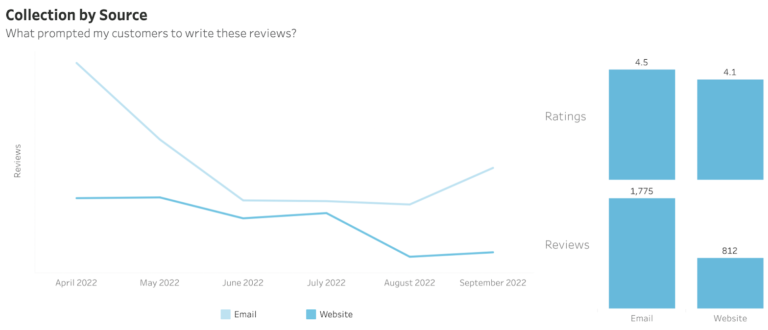
Keep an eye out for trends. Do certain channels drive more positive or more negative reviews? Do some channels, such as text, generate shorter reviews? Consider optimizing your Write-A-Review form or provide yes/no questions they can answer.
6. Reviews by Incentive
This describes the incentive programs you use to collect reviews, such as loyalty points, sampling, or sweepstakes.
Nearly three-quarters (73%) of consumers say they need an incentive to be motivated to write a review. The top incentives include receiving a product for free or before it’s available to the public, or earning discounts or loyalty points with a store or brand. It’s good to track the success of your different incentive campaigns so you can determine which type of incentive is most persuasive to your particular customer set.
Pay attention to how different incentive campaigns affect your review generation and ratings. If one is particularly successful, you may want to regularly run that type of incentive program throughout the year.
7. Review Form Submission Rate
This captures how many reviewers actually complete their review, out of how many started writing a review.
In many ways, the usefulness of your reviews hinges on the success of your Write-a-Review form. Analyzing your form submission rate can reveal potential issues, such as whether the form doesn’t work as well on mobile devices or for certain products.
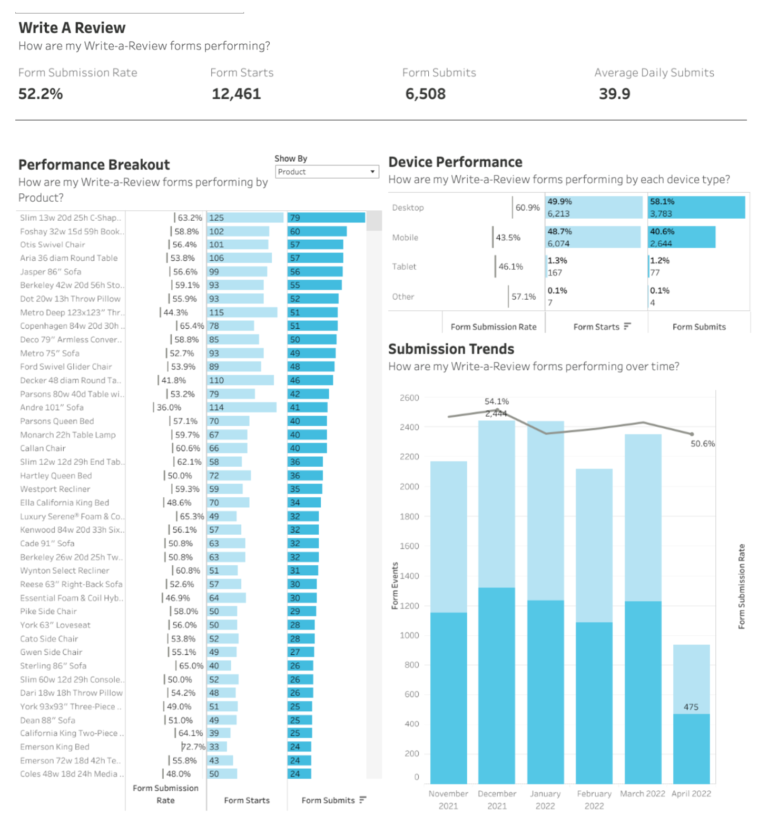
Keep an eye on your review form submission rate. If it suddenly drops on a certain day, or for one type of device, something may be broken. If the review submission rate is much lower on certain products, it may be that some of the questions feel less relevant to that product. You can also experiment with a shorter review form — or making more questions optional — to increase your submission rate.
8. Review Questions
This captures the response rate for individual questions on your review form.
To make their reviews more helpful to customers, many brands and retailers opt to add optional questions to their review form, beyond the standard star rating and blank text box. This is something we always encourage as it improves review quality – which shoppers value highly. However, you want to ensure you are asking the right questions. One way to tell is by seeing the average response rate for these questions, and the average star rating that corresponds with each one.
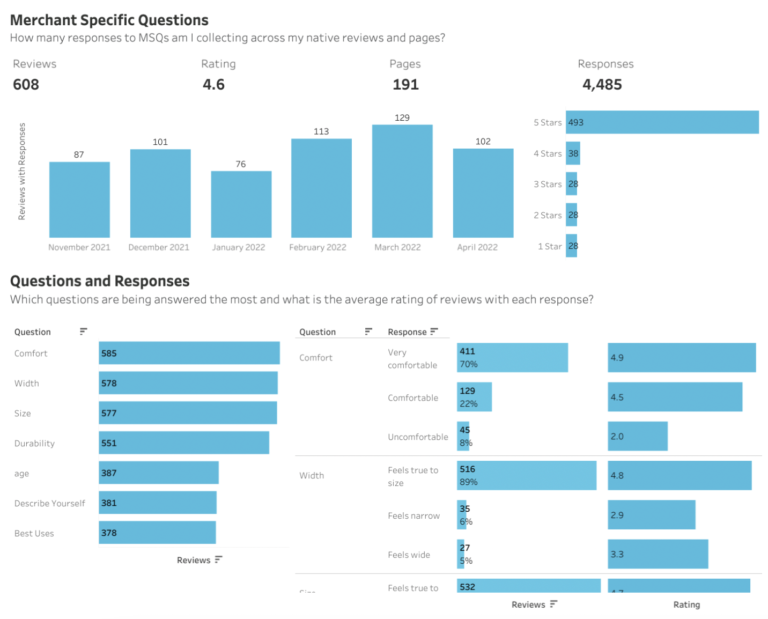
Pay attention to trends with your review questions. If certain MSQs correlate with lower star ratings, that may indicate a product quality issue you need to deal with to improve your ratings — or you may just need to rephrase that MSQ. If you have a hunch you have too many questions on your review form, consider removing some of the less-answered MSQs and see how that impacts your review submission rate.
9. Review Observations
Review observations are rules you set that automatically prevent some content from being published, such as reviews containing profanity or personally identifiable information (PII).
An important part of review content moderation is preventing profanity, PII, and other problematic content from getting published. However, sometimes a reviewer includes some of this content by mistake, like PII — and that can be easily fixed by improving the instructions on your review form.
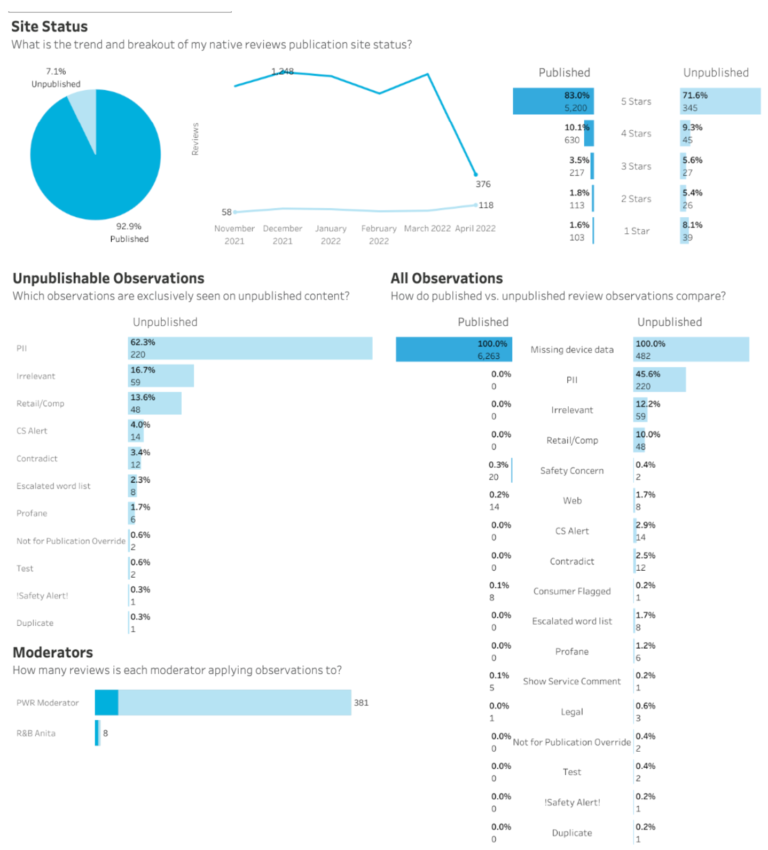
Pay attention to which observations show up often. If you see a lot of PII appearing in your unpublished reviews, consider updating your review form instructions and reminding people not to include PII like their name or location.
10. Review Trends
Review trends describe trends in your native review collection, such as how your star rating, review collection, and review length are trending over time.
Having a bird’s-eye view of how your review collection is going can help you identify potential issues or opportunities. For example, does your review collection soar or slump during certain times of the year?
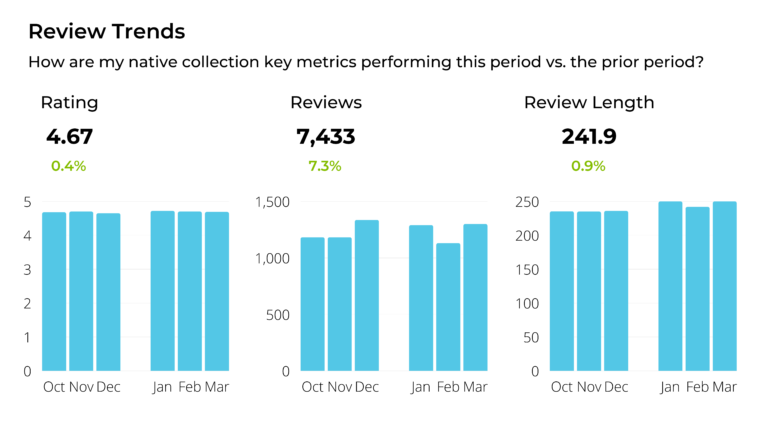
Stay ahead of negative reviews by responding to changes in review trends. If your rating goes down, read the reviews to understand why. If you notice a dip in review length, update your character counter. If you identify slow periods, proactively run a sweepstakes or sampling campaign during that time of year.
Optimize your review collection efforts with review analytics
Review analytics can be the game changer between a decent reviews strategy and an outstanding one. By analyzing your review collection, you can unlock essential insights and discover opportunities to generate more impactful reviews.
If you’re a current PowerReviews customer, you can access all of these metrics in your reporting for free. Not yet a PowerReviews customer? Learn how we can help you do more with UGC.





